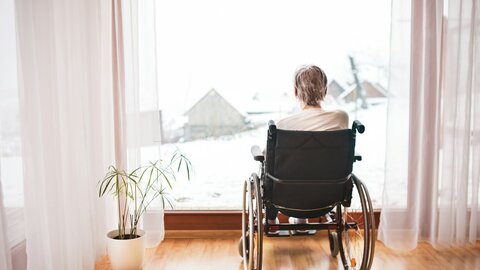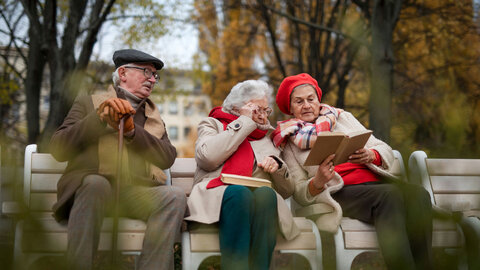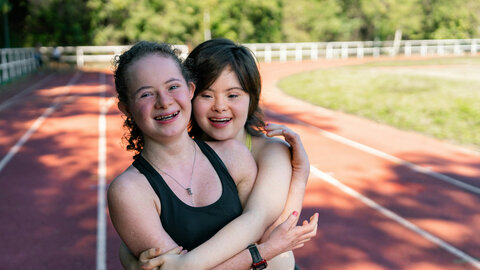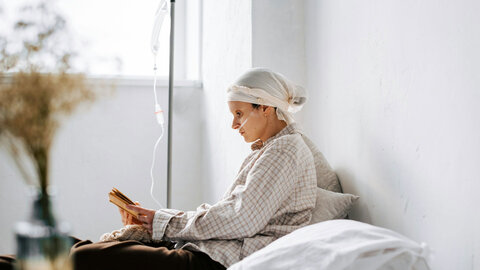Social media as a trigger for self-injury

Cutting oneself with a razor blade, banging one’s head against the wall or giving oneself cigarette burns. Many people have self-injured in these or similar ways at least once in their lives. “In global terms, 15 to 20 percent of people self-harm at least once in their lives. That's a considerable number,” says Oswald Kothgassner, Head of the Research Laboratory for Stress in Childhood and Adolescence at the Medical University of Vienna. “Self-harming behavior increases between the ages of 12 and 18 – and reaches its highest prevalence in the 15th year of life,” explains this clinical psychologist, who has been investigating the triggers for non-suicidal self-injury since the beginning of 2022 in the context of the research project “Online triggers for non-suicidal self-injury”.
A silent cry for help
As Kothgassner explains, self-harming behavior serves first and foremost to cope with intense internal stress, which those affected find almost impossible to bear. Many young people lack appropriate strategies for regulating their emotions, and in moments of emotional turmoil, they seek immediate relief. “By inflicting pain on themselves, they try to relieve internal distress and control their emotions. In addition, self-harming behavior can also be a form of self-punishment or a strategy of communicating with the outside world, i.e. an indirect cry for help to those around them,” notes Oswald Kothgassner.
Kothgassner and his colleagues are interested in the influence of social media on these self-harming behaviors. Young people often share images of self-harm on platforms and messaging services such as WhatsApp, Snapchat, Tiktok or Instagram. In 2017, the media reported a case of a young girl who committed suicide and who had previously indulged in a great deal of content about self-harm and suicide on social media platforms. “We wanted to find out whether images on social media can promote or trigger self-harm”, explains Oswald Kothgassner.
About the project
Studies conducted at the Medical University of Vienna show that young people with mental health issues react more strongly to negative images on social media. The emotions triggered by these images may increase their urge to self-harm, for example.
“Self-harming behavior increases between the ages of 12 and 18.”
Precautionary measures
Following a literature review, Kothgassner and his colleagues, including postdoc Andreas Goreis and Paul Plener, Head of the Department of Child and Adolescent Psychiatry, conducted three studies in the context of the research project. The participants were 50 adolescents aged 12 to 18 – primarily patients at the Medical University of Vienna – who had previously self-harmed plus a control group. The majority of the self-harming individuals were read as female, meaning that other people would describe them as such. Not all of them would identify as female, however.
The researchers checked whether the young people were mentally stable enough to take part in the study. They also gave detailed information about the study to the young people and their parents and obtained their consent. If they all consented, they met to talk about the study design and possible risks. The team applied strict criteria to protect the young people during the trials. “It was possible for the study participants, for instance, to withdraw at any point during the studies and then receive appropriate support,” explains Oswald Kothgassner.
Using artificial blood to gain new insights
In the first step, the researchers wanted to find out whether images can trigger self-injurious behavior. For this purpose, the participants – 25 of whom had already self-harmed and 25 that had never done so – were shown four images on a screen for 200 milliseconds each. Three of these showed neutral motifs and one showed self-harm. The young people were not shown images of real self-harm, but photos of wounds created by a make-up artist on the researchers' forearms and lower legs.
“Developing stimuli in the lab with fake blood and artificial wounds on our own bodies was an interesting experience for us as a research team,” recalls Oswald Kothgassner, since it also required the team to familiarize themselves in depth with the online world of young people.
The results of this study were also exciting, as Kothgassner reports. Adolescents who already had a history of self-injurious behavior quickly took an intense look at the image of self-injury, while those who were not affected reacted in a relatively balanced way. “This suggests an attention bias and is indication of the fact that the problem has a strong cognitive component,” notes Kothgassner.
The pressure is rising
The second study used an app that was installed on the young people's smartphones. For a week, it asked the test subjects several times a day what they were experiencing, whether and how they used social media, whether they felt the urge to hurt themselves or had already done so. The app also offered support by displaying emergency numbers, among other things. Again, the findings were clear. “When we analyzed the data, we saw that negative events on social media, such as online bullying, increased the young people’s urge to harm themselves,” explains Oswald Kothgassner.
“The test subjects were more stressed after these events than after negative events in real life.” Although self-harm did not occur after online events, it did occur after real-life negative events. Kothgassner posits that prior negative experiences on social media may make self-harm more likely after real-life experiences, as they increase the stress level. This hypothesis still needs to be verified.
The pain of exclusion
The third study is currently underway. It is designed to identify situations – online or real life – that trigger self-harming behavior. The study begins with a so-called deception experiment that simulates a situation of social exclusion. The test subjects sit in a room with two other people. They have the task of throwing a ball back and forth. For five minutes, the young test subjects are excluded by not being thrown the ball. In the next step, they again see four images for a very short time, one of which shows self-harm. “We want to see how a group that was socially excluded immediately beforehand reacts to contact with images of self-harm,” explains Oswald Kothgassner. Afterwards, the test subjects are told what the experiment was about.
In another experiment, participants interacted with a computer that mimicked a social media platform similar to Instagram. It displayed posts, including fake self-harm, with varying numbers of likes and comments. While the young people looked through various profiles, the researchers recorded eye movements, heart rate and skin conductance. Over the course of measurements they were also asked several times whether they felt an urge to self-harm and if so, how strong it was. As their heart rate and skin conductance values did not indicate any triggers, the researchers now want to identify other reinforcing factors with more naturalistic stimuli.
Laying the foundation for less suffering
The research project, which received funding from the Austrian Science Fund FWF, is due to be completed in December 2025. Oswald Kothgassner emphasizes that the results have not yet been replicated. The findings, however, are per se revealing. The project provided answers to some questions, showing, for instance, that images on social media increase the pressure to self-harm, but it also raised further questions.
In a potential follow-up study, the researchers would like to gain a better understanding of the specific factors that can trigger self-injurious behavior in everyday life. This knowledge would enable a targeted adjustment of therapies. Those affected could learn to avoid certain situations or deal with them better, which would save many people, especially young people, a great deal of suffering. “That,” says Oswald Kothgassner, “is our goal and our hope.”
Personal details
Oswald D. Kothgassner is a clinical psychologist and head of the Stress in Childhood & Adolescence Research Lab of the Department of Child and Adolescent Psychiatry at the Medical University of Vienna. He has received several awards for his scientific work, including the 2021 Research Award of the Austrian Society for Child and Adolescent Psychiatry. The clinical research project “Triggers Online Resulting in Nonsuicidal Self-Injury” (2022–2025) was awarded EUR 378,000 by the Austrian Science Fund FWF.
Publications
Goreis A., Chang D., Klinger D., Zesch H.E. et al.: Impact of social media on triggering nonsuicidal self-injury in adolescents: a comparative ambulatory assessment study, in: Borderline Personality Disorder and Emotion Dysregulation, Springer 2025
Goreis A., Pfeffer B., Gross C.H., Klinger D. et al.: Attentional biases and nonsuicidal self-injury urges in adolescents, in: JAMA network open 2024
Goreis A., Prillinger K., Bedus C., Lipp R. et al.: Physiological stress reactivity and self-harm: A meta-analysis, in: Psychoneuroendocrinology 2023
Support and advice
There are a number of contact points for adolecents in crisis situations and their relatives. At suizid-praevention.gv.at you can find emergency numbers and first aid for suicidal thoughts. bittelebe.at offers tips on how to talk and behave, especially for children and young people.
Hotlines throughout Austria
Telefonseelsorge: 142
0–24 Uhr, kostenlos
Rat auf Draht: 147
0–24 Uhr, für Kinder und Jugendliche kostenlos
Kindernotruf: 0800 567 567
0–24 Uhr, kostenlos
Kriseninterventionszentrum: +43 (0) 1-406 95 95
Mo–Fr 10–17 Uhr





